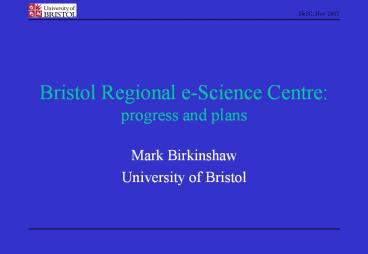Bristol Regional e-Science Centre: progress and plans - PowerPoint PPT Presentation
1 / 15
Title:
Bristol Regional e-Science Centre: progress and plans
Description:
15. NeSC, Nov 2003. Dramatis personae. Balint-Kurti, Orpen (Chemistry) ... May (Computer Science) Taylor (Civil Engineering) Naylor (Physics, Exeter) ... – PowerPoint PPT presentation
Number of Views:17
Avg rating:3.0/5.0
Title: Bristol Regional e-Science Centre: progress and plans
1
Bristol Regional e-Science Centreprogress and
plans
- Mark Birkinshaw
- University of Bristol
2
Outline
- BReSC and CeRB
- BReSC theme data-interactivity
- BReSC progress
- BReSC projects some examples
- WFS viewer AstroGrid-2
- InSAR mapping
- GENIE
- Chemical structures
3
BReSC and CeRB
- Bristol GridPP, GENIE, genomics, digital media,
etc. - UWE Mammogrid
- Exeter eStar, IAs
- Bristol BReSC a component of CeRB
4
BReSC theme
- Data-interactivity NRT DP using local Grid and
display on AG node - Cold and hot media NRT manipulation and
discovery - Example finding structure anomalies and features
in multi-dimensional datasets via combination of
display and calculation astronomy, mathematics,
5
BReSC progress
- AGN site preparation decision for site was
delayed, but now made, orders being placed - eScience PDRA offer made and informally
accepted, will start in December (Bristol will
hire a second PDRA) - Internal Grid under test, switches in place
- Science drivers remain strong, additional
University hires in area (Valdes et al.) - SRIF spend possible significant allocation
being negotiated
6
Projects
- Some examples
- WFSviewer
- GENIE
- InSAR
- Isomerisation
- Others
- Bristol digital media, genomics, earthquake
modelling, volcano predictions - Exeter eStar, Ias
- UWE Mammogrid
7
Wide-Field Survey Viewer
- Designed for a wide-field survey with multiple
wavebands and camera positions - Source detection and merging of object catalogues
- Uses overlaps and stellar colour-colour sequences
to produce uniform photometry - Make, store true-colour images
- Single interface to images catalogues (local or
remote) - Data analysis plug-in modules
8
WFSV data-analysis modules
Slit-mask design interactive slit edits, overlap
checks
Photometry plots e.g. cluster colour-magnitude
diagram
Surface density plot colour-magnitude selected
samples
Remote databases e.g. FIRST catalogue, maps
9
GENIE?
- Grid ENabled Integrated Earth system model
- Investigate long term changes to the Earths
climate using g numerical models - e-Science aims
- Flexibly couple state-of-the-art components to
form unified Earth System Model (ESM). - Execute resultant ESM on a Grid infrastructure.
- Share resultant data produced by simulation runs.
- Provide high-level open access to the system,
creating and supporting virtual organisation of
Earth System modellers.
10
The problem Thermohaline circulation
- Ocean transports heat through the global
conveyor belt. - Heat transport controls global climate.
- Wish to investigate strength of model ocean
circulation as a function of two external
parameters. - Use GENIE-Trainer.
- Wish to perform 31?31 961 individual
simulations. - Each simulation takes ?4 hours to execute on
typical Intel P3/1GHz, 256MB RAM, machine ? 163
days
11
Scientific achievements
Surface air temperature difference between
extreme states (off - on) of the thermohaline
circulation. North Atlantic 2?C colder when the
circulation is off.
Intensity of the thermohaline circulation as a
function of freshwater flux between Atlantic and
Pacific oceans (DFWX), and mid-Atlantic and North
Atlantic (DFWY).
12
Real science through real e-Science
- Delivered Grid resources to perform simulations
of prototype Earth System Model. - Delivered web based system to allow a virtual
organisation of environmental scientists to
create and manage simulations at a high-level. - Delivered database management system to allow
scientists to share, access and visualise data
produced by simulation runs. - New results with profound implications papers
out!
13
Antarctic ice surface velocities satellite InSAR
14
PE profile of isomerisation in NO NH2
15
Dramatis personae
- Balint-Kurti, Orpen (Chemistry)
- Bamber, Payne, Valdes (Geographical Sciences)
- Barker, Edwards, Hall (Biological Sciences)
- Birkinshaw, Bremer, Heath, Miles, Newbold
(Physics) - Green, Nason, Wiggins (Mathematics)
- May (Computer Science)
- Taylor (Civil Engineering)
- Naylor (Physics, Exeter)
- McClatchey, Parmee (UWE)































